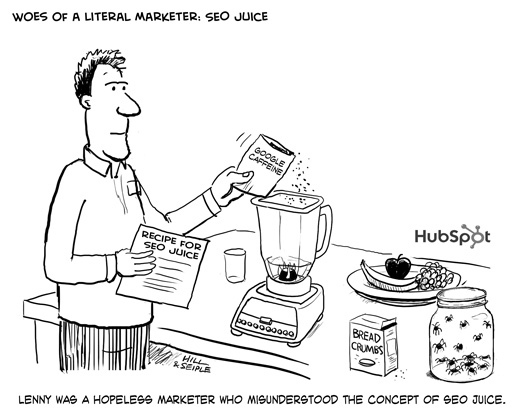Four Signs Your Marketing Strategy is Outdated
It’s 2013 – do you know where your marketing is? The thought should scare you, a bit. Or at least scare you into action. Chances are, your prospects are online, and if they’re not, they will be soon. In the meantime, there are still people online talking about your brand, services, successes, and shortcomings. Why risk your reputation by ignoring this community or by alienating them with outdated marketing techniques?
Inbound marketing gives you all of the tools necessary to move your company forward in harnessing this opportunity. But first, you need to assess where you could be falling short in your current marketing strategy.
1. Messaging
Outdated: You’re stuck on communicating “How good we are”
Modern: You help your prospects determine “What’s the right solution for you?”

Put quite simply: the internet has created empowered consumers. They now have the time, ability, resources, and interest in researching every option before making a decision – it’s all at the tip of their tablet-driven fingers. With this shift in perception, site visitors are now looking at your company with one goal in mind: determining if you have the right product or solution to meet their needs.
Despite this, too many businesses are still approaching their marketing strategy with the old mentality of “we need to showcase just how good our product is.” And while in the time of baby boomer marketing a flashy “come see how shiny this is” strategy was enough to sway your audience, today, it will only alienate them. Because today, deciding on a product or service is no longer about choosing the one you’ve seen the most commercials for, but is rather about choosing the one that best meets your needs.
This decision is hardly made solely on outbound marketing anymore; it has shifted to organic search, online reviews and recommendations, active social relationships, and valuable content that shapes the purchasing decision. Your website messaging, social media participation, SEO, and content marketing strategies should all be founded on a new goal of informing the visitor. Because in the end, an informed prospect is going to a smart prospect, and will lead to high quality retainer relationships for your business.
You want the consumer who wants you, not the one that is unsure.
2. Discovery
Outdated: You employ keyword stuffing and empty link building
Modern: You understand the importance of creating relevant content
 Things that Google does not factor into its algorithm: overdone on-page keyword copy, keywords in meta descriptions
Things that Google does not factor into its algorithm: overdone on-page keyword copy, keywords in meta descriptions
Things that Google flags as negative or punishes in its algorithm: keyword stuffing, faulty or spam link building, non-relevant page copy, pages with too many ads, content farms
Things that Google awards in its algorithm: page freshness, specific, targeted URLs and page titles, human-like copy, relevant content, social media sharing
As a search engine, Google’s #1 prioirity continues to be rewarding content that is written for the reader and not for the ranking. It is always crucial to set your site up properly for SEO and to maintain important keywords to inform messaging and traffic patterns. But these SEO tactics must be used in tandem with original, fresh content creation that benefits the searcher, not to trick him or her into visiting your site. And certainly not to trick Google into ranking your site higher.
These outdated SEO are no longer sneaky enough to outsmart the system. They are also a waste of any good marketer’s time or effort. Instead of compiling your Black Hat SEO Playbook, concentrate on creating the kind of content that will be naturally rewarded for its successes, and that will maintain the reader’s interest because it (point #1) gives them a solution, or at least a little education.
3. Awareness and Retention
Outdated: You rely on push marketing techniques alone (ads, direct mail, cold calling)
Modern: You embrace online engagement

Billboards, magazine ads, commercials, radio jingles, brochures, telemarketing – all push marketing techniques, all things that are hard to measure, show little ROI, and can be an annoyance or turn off. And through it all, have you actually ever spoken to a prospect?
Great marketing (and new business development) only grow from facilitating relationships online. Top companies use social media to pose questions, share knowledge, create discussion, and provide human resource support. They blog often, provide personalization, and use marketing automation or actual sales and marketing team members to communicate with prospects, leads, and customers, pinpointing exactly what kind of resource is needed at each turn.
Once a potential client is familiar with your brand and willing to purchase your product or service, social engagement must continue to be a main point of communication, and especially reflect the previous points of providing the right content and value. It’s also about continued listening: 70% of brands ignore complaints on Twitter, and yet 83% of socially savvy consumers have walked away from a purchase in the past year after a negative customer service experience – compared with 49% of everyone else (The Social Skinny). And while the risk factor is great, the reward is even higher: according to the same source, 55% of people share their purchases socially on Facebook, Twitter, Pinterest and other social sites, essentially, doing your marketing for you.
4. Analysis
Outdated: You count too much on your CEO’s gut feeling
Modern: You actively harness critical behavioral data
 The emergence of website analytics does not mean creativity in marketing has died; it means it has been validated. A/B testing, page performance, sharing statistics, conversion rates – all of these available analytics serve to prove all that your creative (visual or content-based) can accomplish. They also serve to make it better.
The emergence of website analytics does not mean creativity in marketing has died; it means it has been validated. A/B testing, page performance, sharing statistics, conversion rates – all of these available analytics serve to prove all that your creative (visual or content-based) can accomplish. They also serve to make it better.
Human intuition, humor, and the creative process are brilliant things to bring to the table, and should never be taken for granted. But now, when it comes to creating effective marketing campaigns, the behavioral data available today is one of the most powerful tools you can use to build upon these initial intuitive ideas.
Now it’s possible to improve campaigns continiously, to funnel leads and grow sales, to fine-tune your website and branding according to user interaction, and to show proven results at the end of the day. It’s no longer about basing your marketing entirely (and blindly, I might add) on your CEO’s gut feeling of what works from his or her perspective, but rather about considerately tapping into the analytics at hand to build a comprehensive and successful marketing program.
